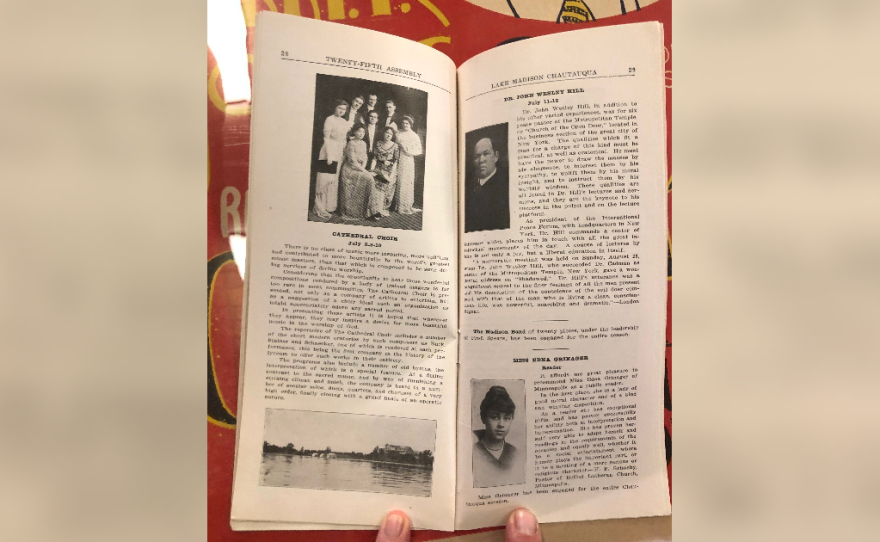In the late 1800s an adult education and social movement swept the nation. It was called Chautauqua - named for the lake in New York where the movement began.
By the 1890s more than 200 Chautauqua events were held nationwide. And one of the more elite events took place each summer on the shores of Lake Madison.
From 1890 to 1931 the three-week event attracted tens of thousands of visitors to the Madison Community.
In addition to cataloguing Chautauqua artifacts, Denise Lewis also gives community talks on Chautauqua to help keep its history alive.
In the early years of statehood - Chautauqua was THE place to be.

“There were hundreds of people. Thousands of people sometimes that attended events at the Chautauqua grounds. It was huge. They had people like former President Taft came and talked. Booker T. Washington – there were preachers and musicians and teachers of all sorts that came and presented workshops and they had concerts. And it was an opportunity to see things that you couldn’t see if you were a local person in you know, 1900,” said John Nelson.
“People would come from Sioux Falls, Minneapolis, Sioux City, Iowa and they’d catch the train to Madison. And then there was an extra spur railroad that was created to take people directly out to the Chautauqua grounds,” said Julie Breau.
“It was a historic movement in the country and this happened to be the location of one of the most successful in the Midwest, right here on Lake Madison,” said Denise Lewis.
You just heard the voices of Madison historians John Nelson, Julie Breu and Denise Lewis.
Chautauqua was a traveling education and entertainment event that connected citizens across the nation to a shared line-up of popular entertainers and authors and politicians and thought leaders.
“Miss Minnie May Lewis, June 28th to July 10th. Children's entertainer, reader and lecturer is exceptionally well qualified to meet the demands of the Chautauqua audiences, which are everywhere, becoming more critical and demanding higher class attractions in order that she might be more useful in settlement work.”
Julie Breu Director of the Lake County Museum reads excerpts from a 1915 Chautauqua Program.
“Walden. Magician and illusionist. The engagement of Mr. Walden, the great magician on the Chautauqua program for July 5th, sixth and seventh promises a change from the regular routine. He proposes to rest our emotional senses and arouse the faculty of forthcoming mysteries. He also promises to please and fascinate the eye with beautiful creations and magic.”
“I think it helped bring the country together after the Civil War. The ideas – it made South Dakota and pulled us into the national thought process of you know the politicians and the entertainment. We were experiencing what other communities were experiencing,” said Breu
The Lake County Museum where Breu works houses one of the largest collections of Chautauqua artifacts. And it’s where volunteer Denise Lewis has donated hundreds of hours researching and cataloguing the Lake Madison Chautauqua collection of programs, flyers, meal coupons and photographs.
“Chautauqua exposed the community, every community that it existed in, it exposed people to the things they wouldn’t get to see otherwise. Because if you put yourself back in that era, there was no internet, there was no ability to get educated online, there was no ability to watch a concert online,” said Lewis.
While most host communities put up temporary, circus-size tents for Chautauqua, the Chautauqua grounds at Lake Madison were home to permanent Chautauqua structures – a 2500-seat Auditorium, Grand Hotel and Swimming Pavilion.
Chautauqua attendees took full advantage of all Lake Madison had to offer.
Denise Lewis.
“There was lots of recreation. People would do the same things they do today at the lake, they fish, they boat they get out on the water, they swim. They had slides and swim platforms built. They had a boat house. There were canoes and rowboats to rent. There were leisure cruise boats and a steam-powered boats that would take you out on a scenic cruise of the lake,” Lewis said.
Lewis became interested in Chautauqua because she grew up on Lake Madison and her childhood home sits across the lake from where the Chautauqua grounds once stood. And even though the last Chautauqua was held in 1931 and the event’s permanent structures were long ago replaced by modern homes, Lewis feels strongly about the lasting impact Chautauqua had on the community of Madison.
“It’s a significant part of our local history. And people may or may not realize that it spurred our growth. And Madison has prospered ever since,” Lewis said.
Visit the Lake County Museum to see Chautauqua artifacts for yourself or thumb through a 1915 Chautauqua program of events in the gallery below.




















